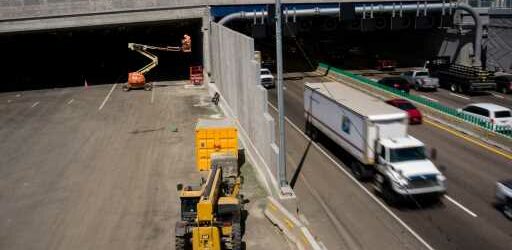Drivers traveling east on Interstate 70 through Denver will get more room to spread out early next week when an expansion project hits a major milestone — marking the beginning of the end for the four-year-old undertaking.
By early Monday morning, a traffic shift will move eastbound traffic between Brighton and Colorado boulevards, the gnarliest work zone of the $1.3 billion Central 70 Project, into its final placement on the south half of the highway. To the north, the westbound side of the highway still will have a couple more months of finishing work to go. For more than a year, that side has hosted both directions of traffic, squeezed into a temporary configuration that will need to be undone.
But finally, the end of the project is in sight: Its contractors are aiming to complete major construction on the entire 10-mile project this fall.
“I know the community and the traveling public is ready for the project to be over, and we’re excited to deliver a quality project,” said Bob Hays, the Colorado Department of Transportation’s Central 70 project director, during a media tour Wednesday morning on the new eastbound lanes’ freshly set asphalt.
To prepare for the eastbound traffic shift, crews will close all eastbound lanes between Washington Street and Interstate 270 through the coming weekend, starting at 10 p.m. Friday. Traffic will be rerouted on a detour that uses Interstate 76 to I-270. Westbound I-70 won’t be affected.
By 5 a.m. Monday, fresh pavement will welcome the three regular eastbound lanes to the south side of the highway.
The change comes with a request by project officials for drivers to watch their speeds, now that the road will be smoother and roomier. The only thing left in coming months, CDOT says, will be the gradual opening and testing of an express lane that’s already in use, without tolling, east of Colorado Boulevard.
Project won’t fix congestion but may smooth flow
One word of caution: Don’t expect the project to cure I-70 of congestion, even once it’s complete.
The highway carries about 200,000 vehicles a day. Given the project’s limited goals — to bring I-70 up to federal highway standards and add an express lane in each direction — capacity will still be tight.
“What I’ll say is the safety features are going to help improve the flow of traffic,” Hays said. “So we’re going to have the full-width shoulders. We’re going to have standard (acceleration and deceleration) lanes for all of the ramps. … Come Monday, we will have the full length of deceleration lane needed in order to get off (I-70) at Steele and get off at Colorado.”
On the westbound side, crews will spend the next two months removing the median barrier that separated the temporary eastbound lanes and reconfiguring safety equipment. They also will carry out final paving, requiring some overnight lane closures, along with restriping to accommodate the final westbound lanes, including a new express lane.
The target to finish all that up is mid-September.
Since breaking ground in August 2018, the Central 70 project has widened I-70 between Interstate 25 and Chambers Road in Aurora, reconstructing portions of it. Most work east of Colorado has been done for a while.
(Click to enlarge)
But the most complex construction has occurred in the 1.8-mile stretch where a raised highway span used to ferry traffic between Brighton and Colorado, northeast of downtown. Crews built a new, recessed highway north of that viaduct and are working on a 4-acre cover park above it next to Swansea Elementary School, to help knit the Elyria-Swansea neighborhood together.
Construction crews with the contracting team, Kiewit-Meridiam Partners, approached the work in two phases. When the north side of the new highway section was complete in May 2021, project managers diverted all traffic into it to share what would be the eventual westbound lanes.
Then crews demolished the 57-year-old viaduct structure last summer, making room to dig out the rest of the new section — the side that will open to eastbound traffic on Monday.
Recent work made quick progress
Hays stood Wednesday inside the 1,000-foot tunnel beneath the park cover’s structure. He noted features of that lengthy tunnel, including a variable lighting system that attempts to match the brightness outside the tunnel on sunny days, making the transition easier for drivers. A ventilation system includes nine jet fans at the entrance that can quickly clear smoggy air or smoke in the event of a tunnel fire.
While he spoke, Denver firefighters sprayed fire hoses connected to the tunnel’s fire hydrants, testing the water pressure.
Construction moved more quickly during the second phase of tunnel construction.
“The build-out of this eastern bore, the southern half of the cover, has gone so extremely well because we learned all the lessons on the northern bore,” Hays said. “This is just — you know, we call it ‘rinse and repeat.’ ”
Despite early setbacks and delays, the project largely has gone smoothly. The contractors by December are aiming to reach the contractual “substantial completion” mark, which leaves just minor completion work for early next year. If they hit that mark, they’ll earn a $2.5 million incentive under a settlement with CDOT that resolved project cost disputes.
Still, that would be about nine months behind the original schedule’s March target.
Aside from finishing up the westbound lanes, plenty of work remains on the cover park, where structures are starting to take shape. Crews have about four months to build out and landscape its many elements, including a central plaza, a multi-purpose playing field and an events lawn with a stage. They’re aiming for a mid-November opening for the new Denver public park.
Down on the highway, Hays says the express lanes — which extend east to Aurora — likely will begin charging tolls early next year.
Source: Read Full Article






